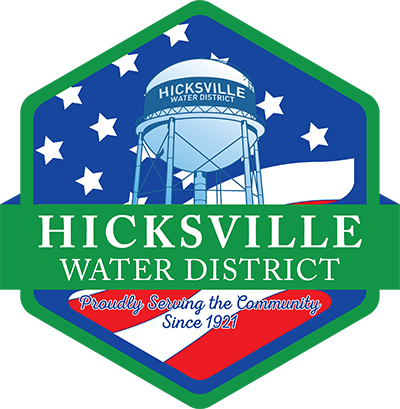Facilities
Water Plant Facilities
Plant 1
Site of the district’s first air-stripping facility (constructed 1983). A 155-foot elevated storage tank holds 1.25 million gallons of water.
Well #1-4 (1965)
Commissioners
Harry Borley, Chairman
William A. Cisler, Treasurer
George A. Kunz, Secretary
Superintendent
Harold F. Hawxhurst
Depth – 545 feet
Daily pumping capacity – 1.086 million gallons
Well #1-6 (1980)
Commissioners
Stanford Weiss, Chairman
Harry Borley, Treasurer
Gilbert E. Cusick, Secretary
Superintendent
Louis G. Dettloff
Depth of well – 583 feet
Daily pumping capacity – 1.567 million gallons
Plant 3
Well #3-2 (1969)
Commissioners
Harry Borley, Chairman
William A. Cisler, Treasurer
George A. Kunz, Secretary
Superintendent
Harold F. Hawxhurst
Depth of well – 505 feet
Not in service at this time.
Plant 4
A 196-foot elevated storage tank holds 500,000 gallons of water.
Well #4-2 (1969)
Commissioners
William A. Cisler, Chairman
Harry Borley, Treasurer
George A. Kunz, Secretary
Superintendent
Harold F. Hawxhurst
Depth of well – 601 feet
Daily pumping capacity – 774,000 gallons
Plant 5
Ground-level storage tank holds 2 million gallons of water. Air-stripping facility added in 1992.
Well #5-2 (1965)
Commissioners
Harry Borley, Chairman
William A. Cisler, Treasurer
George A. Kunz, Secretary
Superintendent
Harold F. Hawxhurst
Depth of well – 551 feet
Daily pumping capacity – 300,000 gallons
Well #5-3 (1977)
Commissioners
Harry Borley, Chairman
Gilbert E. Cusick, Treasurer
Stanford Weiss, Secretary
Superintendent
Louis G. Dettloff
Depth of well – 610 feet
Daily pumping capacity – 1.024 million gallons
Plant 6
Well #6-1 (1952)
Commissioners
Charles E. Colthurst, Chairman
William A. Cisler, Treasurer
Harry Borley, Secretary
Superintendent
Fredrick R. Davidson
Depth of well – Originally 419 feet
re-drilled to 615 feet in 2001
Daily pumping capacity – 1.6 million gallons
Well #6-2 (1952)
Commissioners
Charles E. Colthurst, Chairman
William A. Cisler, Treasurer
Harry Borley, Secretary
Superintendent
Fredrick R. Davidson
Depth of well – 428 feet
Daily pumping capacity – 498,000 gallons
Plant 7
Well #7-1 (1958)
Commissioners
Harry Borley, Chairman
William A. Cisler, Treasurer
George A. Kunz, Secretary
Superintendent
Frederick R. Davidson
Depth of well – 605 feet
Not in service at this time.
Plant 8
Location of district’s administration offices and vehicle and equipment storage facilities. Air stripping facility constructed in 1990.
Well #8-1 (1958)
Commissioners
Harry Borley, Chairman
William A. Cisler, Treasurer
George A. Kunz, Secretary
Superintendent
Frederick R. Davidson
Depth of well – 632 feet
Daily pumping capacity – 336,000 gallons
Well #8-3 (1977)
Commissioners
Harry Borley, Chairman
Gilbert E. Cusick, Treasurer
Stanford Weiss, Secretary
Superintendent
Louis G. Dettloff
Depth of well – 637 feet
Daily pumping capacity – 578,000 gallons
Plant 9
Ground storage tank holds 2 million gallons of water.
Well #9-1 (1971)
Commissioners
William A. Cisler, Chairman
Harry Borley, Treasurer
W. Arnold Jeanson, Secretary
Superintendent
Harold F. Hawxhurst
Depth of well – 590 feet
Daily pumping capacity – 1.072 million gallons
Note: Rehabilitated in 1999 under leadership of Commissioners Nicholas J. Brigandi, Gilbert E. Cusick and Richard A. Humann and Superintendent William E. Schuckmann.
Well #9-2 (1971)
Commissioners
William A. Cisler, Chairman
Harry Borley, Treasurer
W. Arnold Jeanson, Secretary
Superintendent
Harold F. Hawxhurst
Depth of well – 585 feet
Daily pumping capacity – 420,000 gallons
Well #9-3 (1986)
Commissioners
Nicholas J. Brigandi, Chairman
Stanford Weiss, Treasurer
Gilbert E. Cusick, Secretary
Superintendent
Richard E. Woodwell
Depth of well – 600 feet
Daily pumping capacity – 1.486 million gallons
Plant 10
Well #10-1 (1980)
Commissioners
Stanford Weiss, Chairman
Harry Borley, Treasurer
Gilbert E. Cusick, Secretary
Superintendent
Louis G. Detloff
Depth of well – 625 feet
Daily pumping capacity – 480,000 gallons
Note: Rehabilitated in 2003 under leadership of Commissioners Gilbert E. Cusick, Nicholas J. Brigandi and Richard A. Humann and Superintendent William E. Schuckmann.
Plant 11
Well #11-1 (1988)
Commissioners
Richard A. Humann, Chairman
Gilbert E. Cusick, Treasurer
Nicholas J. Brigandi, Secretary
Superintendent
Richard E. Woodwell
Depth of well – 700 feet
Not in service at this time.
Air-Stripping
Based on the principal of exposing a large surface area of water to air, the process is relatively simple to understand. Water is pumped to the top of a tower and then cascades downward over a large number of packing materials or small round objects that look like ping-pong balls. At the same time, filtered air is blown upward through the tower, breaking the water molecules and removing or “stripping” any contaminants in its travels.
Advanced Oxidation Process (AOP)
The most promising form of treatment for removing 1,4-dioxane from drinking water is the Advanced Oxidation Process (AOP). AOP treatment blends raw groundwater with a low concentration of an oxidant—most commonly hydrogen peroxide—that then goes through a sophisticated ultraviolet light reactor that then destroys 1,4-dioxane molecules.
Once groundwater goes through the AOP process, that water is then piped into Granular Activated Carbon (GAC) vessels. From here, water is chlorinated, tested and then goes into the distribution system.
Granular Activated Carbon (GAC)
Granular Activated Carbon (GAC) vessels—which are industrial-sized carbon filters—remove volatile organic compounds (VOC) from the water. They are required components for the treatment of 1,4-dioxane as the GAC vessels also capture and remaining oxidant left in the water once it goes through the Advanced Oxidation Process.



